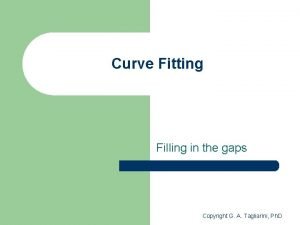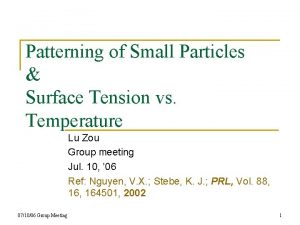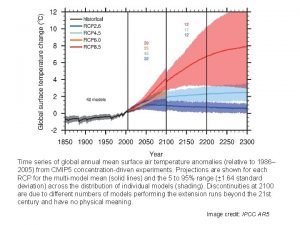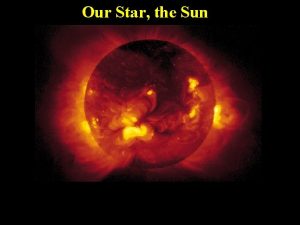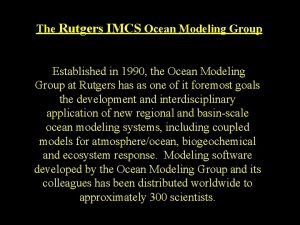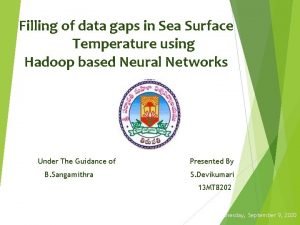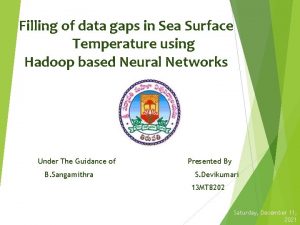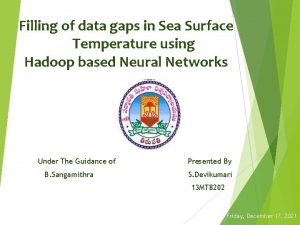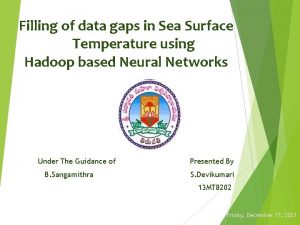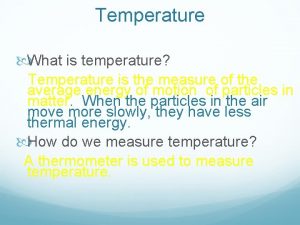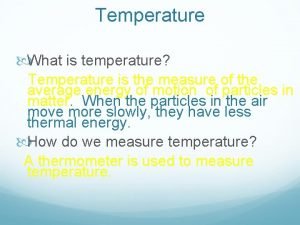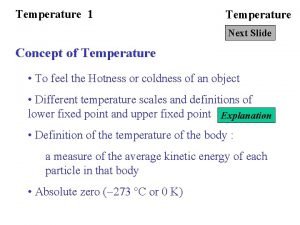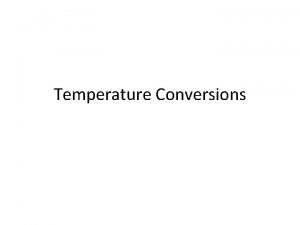Filling of data gaps in Sea Surface Temperature























- Slides: 23

Filling of data gaps in Sea Surface Temperature using Hadoop based Neural Networks Under The Guidance of B. Sangamithra Presented By S. Devikumari 13 MT 8202 Friday, October 15, 2021

Contents Abstract Introduction Existing system Proposed system Data Processing With Hive Algorithm Uml diagrams Neural network model Neural network steps Output Conclusions References

Abstract Forecast on Large scale satellite data that are generated continuously by multiple sensors in daily communications are possessed high significance for analyzing the behaviors of huge amounts of data. However, the natural properties of satellite data present three non-trivial challenges: large data scale leads it difficult to keep both efficiency and accuracy; similar data increases the system load; and noise in the data set is also an important influence factor of the processing result and need to be worked efficiently with the neural networks on large data sets. Data is divided into separated segments, and learned by a same network structure. A Hadoop based framework called HBNN (i. e. Hadoop-based Back propagation Neural Network) is proposed to process forecast on large-scale SST data. It uses a Back propagation algorithm which provides greater efficiency, good scalability and anti-noise.

Existing system Traditional methods used for filling of data gaps are not effective for non-stationary and non-linear time series data. In case of missing data and when its location is random there is no solution is provided Proposed system The SST gap filling (missing data) problem can be solved through Hadoop based Neural Networks . We suggest an approach to solve the above mentioned problem i. e. , recovery of missing data in time series using artificial neural networks.

Data Processing With Hive is a database technology that can define databases and tables to analyze structured data. Hive is a data warehouse infrastructure tool to process structured data in Hadoop. It resides on top of Hadoop to summarize Big Data, and makes querying and analyzing easy. So here Hive database is used to format unstructured data

Hive Queries create table SST_DATAtable (col_value STRING); LOAD DATA INPATH '/home/hadoop/training/hive/SSTdata. csv' OVERWRITE INTO TABLE SST_DATA ; create table SSTdata (U 1 string, U 2 string, WV string, CLW string, RR string); insert overwrite table SSTdata SELECT regexp_extract(col_value, '^(? : ([^, ]*), ? ){1}', 1) U 1 string, regexp_extract(col_value, '^(? : ([^, ]*), ? ){2}', 1) U 2 string, regexp_extract(col_value, '^(? : ([^, ]*), ? ){3}', 1) WV string, regexp_extract(col_value, '^(? : ([^, ]*), ? ){4}', 1) CLW string, regexp_extract(col_value, '^(? : ([^, ]*), ? ){5}', 1) RR string, regexp_extract(col_value, '^(? : ([^, ]*), ? ){6}', 1) SST_data string from SST_DATAtable;

Backpropagation Algorithm

Flowchart

Class Diagram

Sequence Diagram

Use Case Diagram

Neural Network Model

Steps for Neural Network Step 1: We can start the neural network tool using the nntool command Step 2: Select the import. It will display the following window. Step 3: Here brows the input and target datasets load from disk files.

Step 4: Create a Network

Step 5: Train the Perception Now click the Train tab. Specify the inputs and output by clicking the Training Info tab and selecting the inputs to trained input, and the targets to trained target. Click Train Network to train the Feed-forward backprob network. The following training results appear.

Training Phase

Performance of SST Data

Training State of SST Data

Regression of SST Data

SSTDATA OUTPUT

Conclusions The main objective of this study is to retrieve missing values in the measured sea surface temperature time series data. The proposed Hadoop based neural networks(HBNN) is well trained and tested in filling the SST data gaps with possible error estimation and correction. Our results show that the efficacy of the estimation procedure and thus the reliability of the estimated missing values are dependent on a number of factors.

References “Using MATLAB to Develop Artificial Neural Network Models for Predicting Global Solar Radiation in Al Ain City – UAE “Maitha H. Al Shamisi, Ali H. Assi and Hassan A. N. Hejase United Arab Emirates University United Arab Emirates 4 -1 -2014 “Big Data Analy tics U sing Neural network” Chetan Sharma 4 -1 -2013 “Modular Approach to Big Data using Neural Networks” - Animesh Dutta “Recovering data gaps through neural network methods”-A. Gorban and A. Rossiev-Institute of Computational Modeling, Krasnoyarsk, Russia-N. Makarenko and Y. Kuandykov Institute of Mathematics, Almaty, Kazakhstan V. Dergachev-Ioffe Physical and Technical Institute, St. Petersburg, Russia

Any Queries… Thank You
 Fills in gaps in data and fit data into curves
Fills in gaps in data and fit data into curves Difference between curie temperature and neel temperature
Difference between curie temperature and neel temperature Difference between curie temperature and neel temperature
Difference between curie temperature and neel temperature Difference between curie temperature and neel temperature
Difference between curie temperature and neel temperature Led soldiers across hellespont into anatolia goals
Led soldiers across hellespont into anatolia goals What is asias largest desert
What is asias largest desert Hydra sea anemone
Hydra sea anemone Marlin symbolism
Marlin symbolism Sea cave
Sea cave Surface tension vs temperature
Surface tension vs temperature Jupiter surface temperature
Jupiter surface temperature Global mean surface air temperature
Global mean surface air temperature Star
Star Rutgers sea surface temps hudson canyon
Rutgers sea surface temps hudson canyon Lateral surface area of rectangular prism formula
Lateral surface area of rectangular prism formula Spin coat
Spin coat Curved surface area and total surface area of cone
Curved surface area and total surface area of cone Use of some
Use of some Gap model of service quality
Gap model of service quality Provider gap
Provider gap Horizontal communication
Horizontal communication Fill in the gaps using
Fill in the gaps using Customer service strategies in retail
Customer service strategies in retail Complete the gaps with the past perfect or the past simple
Complete the gaps with the past perfect or the past simple
